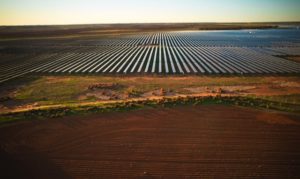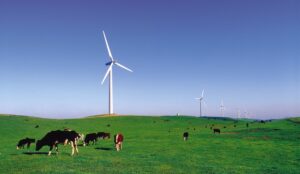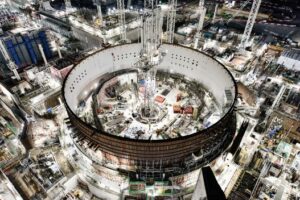A New South Wales project that proposes to be the biggest single renewable energy generator on Australia’s main grid – and produce twice the output of the state’s soon-to-be retired Liddell coal power plant – is investigating plans to add pumped hydro as one of its core energy storage components.
The 4,000MW (4GW) Walcha Energy Project is proposed for near the town of the same name, about 55km south of Armidale in the New England tablelands, by co-developers Energy Estate and MirusWind.
The early-stage plan is to combine wind and solar, and add in storage such as pumped hydro and/or batteries, and create a new substation and “renewable energy hub” near the town of Uralla.
But as of this week, Energy Estate and MirusWind have joined forces with pumped hydro specialist ARUP, to explore the option of using an existing council-owned dam as part of a new pumped hydro scheme that could store between 500MW-1GW of solar and wind power for between four-to-six hours.
The consortium has signed a Memorandum of Understanding (MoU) with the Tamworth Regional Council to conduct a study into the feasibility of building a pumped hydro scheme around the existing the 16.4 megalitre Dungowan Dam – a solution it says could be “fundamental game changer.”
That study, and those which would follow, including full feasibility, detailed design and revenue modelling, could take anywhere from one to two years to complete, before any final investment decision could be made.
But the the members of the consortium seem confident of its credentials. And not just because of the benefits that up to 1GW of pumped hydro storage would offer to the rapidly changing local grid.
“We assess sites around the country and do a lot of work for third parties,” said ARUP’s regional business leader, Stephen Thompson.
“We identified Dungowan Dam as a key location for pumped hydro, because of its location on the transmission network. But once we started looking at that location, we also found it was strategically convenient for water storage solutions, too,” he said.
“We are now looking at how we can blend in a major water solution for the region as well as energy storage for the grid, as well.”
“We believe the combination of both the water and energy solutions is a fundamental game changer,” he said.
And indeed it may be. For Tamworth Council, the 1957-built Dungowan Dam has been a focal point of concerns around water infrastructure and security. As one of the drought-affected town’s main water supplies, it is in dire need of an expensive upgrade.
But a recent council feasibility study ruled a proposed upgrade to the Dam as “cost prohibitive” and the plans were put on the back-burner.
In terms of the Walcha Energy Project, the plan for the Dungowan Dam – which is located at the southern end of the hub – would be to add an upper reservoir, at a height difference of around 550 metres above the original dam.
Not only would this provide flexible energy storage capacity for Walcha, but it would have the dual benefit of enhancing water security for the surrounding region.
In comments in the local paper, Tamworth Regional Council water director, Bruce Logan acknowledged the potential synergy, noting that “if the project did get off the ground, we might have some more water available for the Tamworth community.”
“The Walcha plateau is a good area for wind and solar generation and [the consortium] feel there may be some synergies between that and a pumped hydro scheme,” Logan told the Leader.
For Simon Currie, a founder of Energy Estate, the addition of pumped hydro in this way would fit perfectly with the Walcha project’s strong community focus.
“We’re very lucky to have teamed up with ARUP … and to have that team based in Australia. And we’re very lucky to have a close working relationship with the Council,” Currie told RenewEconomy on Thursday.
“This (MOU) is about how we can enhance the security of the water supply and enhance energy security, in a cooperative manner with Tamworth Regional Council,” he said.
“If the upper dam was made larger, it could make more use of the catchment area. So we could actually (arrive at) much better outcomes where you’ll get the water supply enhanced, together with the energy supply, while generating regional economic development and jobs,” said MirusWind director, Mark Waring.
“In a flood event, you would use the pumps to ensure most of the water is in the top dam, so it could effectively deal with dam safety, too.”
In terms of energy security, there is a lot on offer, too, in light of the Walcha Energy Project’s strategic position on the grid.
“This project sits proximate to the (transmission) lines coming down from the Hunter Valley coal plants,” Currie said.
“We all know that there’s going to be a transformation of the Hunter. So it’s well worth our effort to spend time on this dam and work out whether it needs to be in the mix.
As we reported here just two weeks ago, the first stage of the Walcha hub could be up to 1GW of wind and 400MW of solar, and is expected to begin construction in 2020, delivering its first output by 2022 – right about the time when AGL’s now 1.6GW Liddell coal plant is scheduled to close.
“Pumped hydro energy storage has to be a part of this. We’ve actually got to be looking at how to address the long-term capacity needs from the Hunter up,” he said, noting that it was effectively on the other side of the NSW grid to the planned Snowy Hydro 2.0 scheme.
ARUP’s Thompson says a Dungowan Dam pumped hydro system could support not only the 4GW of renewables being proposed for Walcha, but other projects, too.
“The revenue streams that exist for pumped hydro projects will, as the network changes, just continue to grow,” he said, noting that after the closure of Liddell, the Rails Point and Eraring power stations would probably be “the next cabs off the rank” in coal retirement.
“We’re going to need more firming support for wind and solar farms and we’re going to have a bigger role there with balancing the afternoon and evening load as we get more PV generation in the system,” he said.
Another party that will no doubt be closely monitoring the progress of the feasibility study is the Australian Energy Market Operator, which has put replacement of outgoing coal-fired power capacity in New South Wales, and particularly Liddell, among the top priorities of its Integrated System Plan.
“We know – AGL has told us – that Liddell is going to retire, AEMO has looked at that, so we absolutely need to get new resources into NSW,” AEMO chief Audrey Zibelman told a Melbourne CEDA event on Wednesday.
“That has to be done, not just in time… but in advance, so that we can get it done and make sure that when that plant retires, we have the capability to meet those needs and that helps us integrate, also, additional renewables,” she said.
And Currie agrees. “I’m a great believer, now, that we’ve got to look at how we use our (existing) energy infrastructure. This isn’t just about building new things, this is about thinking more cleverly about what we’ve got, and in a consultative way, trying to design the best system going forward.”










